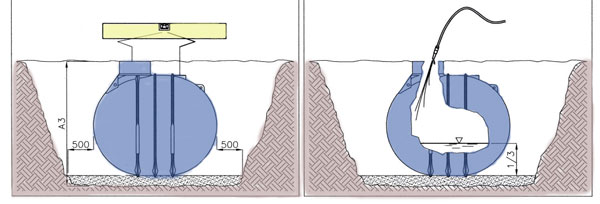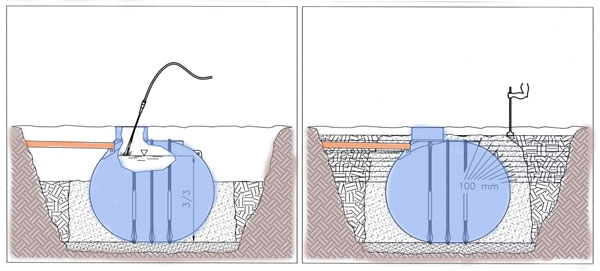- favorite 6 likes
- remove_red_eye 25410 views
- comment 0 comments

Installation of underground tanks for rainwater, septic tank, drinking water
Choosing the right location for the tank
Before proceeding to further work, a suitable installation site must be selected. It should be remembered is necessary to maintain suitable distance from neighboring buildings and that the area above the tank cannot be built-up. In the case of installation of tanks in areas where road traffic is planned (passenger cars, buses, trucks), special equipment and elements of additional equipment should be used (cast iron covers with a given load strength class, adapters for cast iron covers and appropriate foundation according to the manufacturer's instructions). The place of installation should be prepared, tidy with a prepared place for aggregate and a maneuvering area for an excavator. During installation, pay attention to the pipes and cables in the ground, as well as vegetation (e.g. tree roots).

Preparation of the excavation
The excavation should be adjusted to the dimensions of the tank increasing by the amortization space for covering the tank on all sides, approx. 20-30 cm. The walls of the trench should be stable. At the bottom of the trench, should place a compacted, previously prepared, leveled bedding. The material for the ballast must be compactable, permeable, free of sharp objects, frost-resistant, free of clays, loams, etc.

Placing the tank in the excavation
After placing the underground rainwater tank, it should be well leveled. This operation must be repeated regularly when filling the tank so that it does not change its position.

Backfilling and soil compaction
The tank should be gradually filled with water, at the same time filling the tank in stages, checking from time to time if it is well leveled. Water must not be poured into the trench, as it has a negative effect on soil compaction and stability.

Connecting the inflow and outflow
The next stage of assembly is connecting the pipelines. This should be done with the correct slope. After all, it is necessary to check the durability of connections of the pipelines with the inlet and outlet ports.
Keep in mind that pipes must be buried deep enough to prevent freezing.
Tank relieving elements
In the case of very unfavorable water and ground conditions, it may be necessary to use a sufficiently thick layer of aggregate or material in order to load the tank from the top so as to prevent its displacement.
Detailed information on the installation of specific models of rainwater tanks is described in detail in the technical and commissioning documentation.

Comments (0)